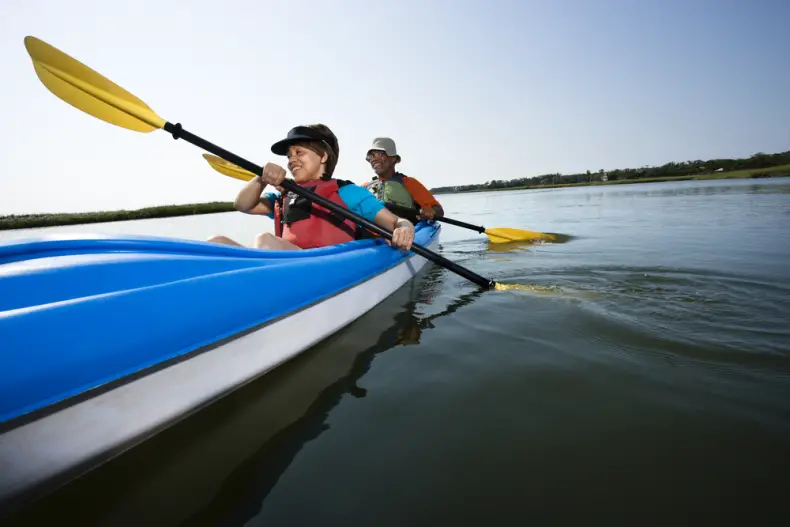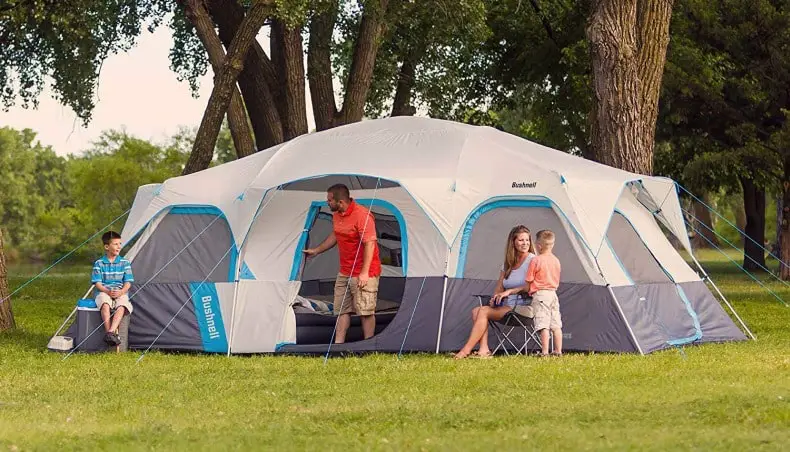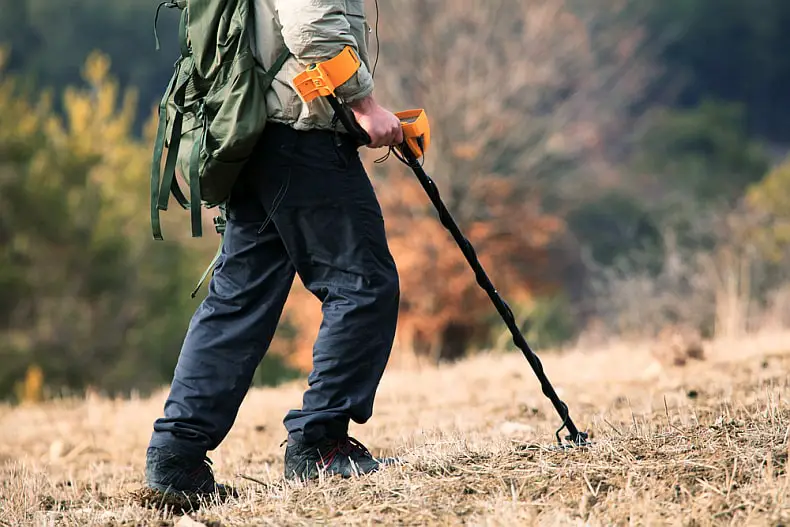Tandem kayaking, as the name indicates, is kayaking as a couple or three people. For kayaking to be considered “tandem”, there should be at least two kayakers onboard. Tandem kayaking is an excellent way to spend some quality and fun time with your friends and family. If you have kids, tandem kayaking can be a great way to introduce kayaking to your kids. Of course, you need a tandem kayak for the purpose.
In this detailed guide, we’ll discuss everything that there is to buying a tandem kayak, besides offering you some solid tandem kayak recommendations. If you’re in the market to buy best the tandem kayaks for the money, read this before you put your money on the table.
Table of Contents
Benefits Of Tandem Kayaking
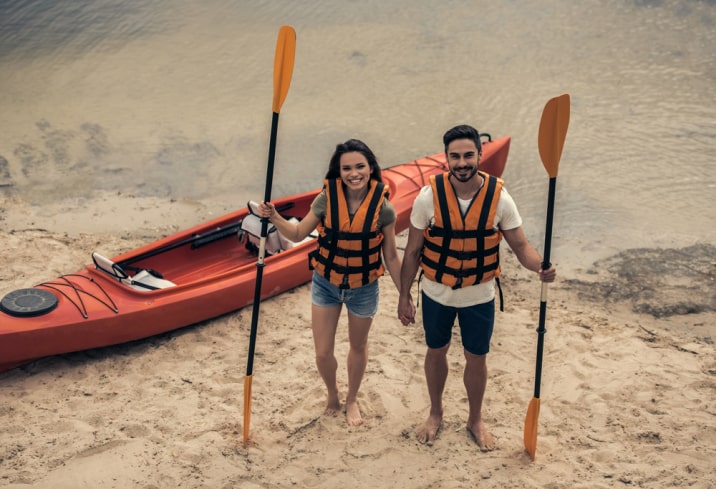
Kayaking is such a fun way to spend an active day out on the water! In fact, it is often so fun you don’t even realize just how much activity you’re getting or how long you have been out on the water. Neither of those is a bad thing at all when you realize the many health benefits of kayaking.
Kayaking can reduce stress levels, clear your mind, and elevate your mood. It’s also a great workout and burns quite a few calories while toning and strengthening your muscles.
While paddling the kayak, you are obviously working your core and arm muscles, but surprisingly kayaking also works to strengthen and tone the muscles in your legs as well, as you use your legs to stabilize the kayak and turn your torso.
Kayaking is also great for cardiovascular health and a really good way to soak up some much needed Vitamin D.
Another benefit of kayaking is spending quality time with someone you love. Tandem kayaks, specifically, create a great opportunity for you to go out onto the water with a loved one.
Imagine a beautiful, sunny day spent gliding through the water in a tandem kayak with your favorite person along for the ride! If you have never been kayaking at all, or have never been in a tandem kayak, you are in for such a treat!! Not only will you enjoy yourself and experience the calming beauty of nature, but you will also be making incredible memories together.
Why Buy A Tandem Kayak?
A tandem kayak is great for people who like kayaking as a couple. Friends and families who have tandem kayaked before would tell you how fun and exciting the activity can turn out to be. Spending a significant amount of time together on an adventure boat could help create or strengthen the bond between parents and their children, friends, etc.
The following are reasons you may need a tandem kayak.
Kayaking as a Family
If you have a family that is as excited about kayaking as you are, you need a tandem kayak. This is particularly the case if there are small children in your house who you would like to introduce to paddling.
Cannot Go Solo Yet
If you are new to kayaking and the very thought of taking the boat all by yourself sounds overwhelming and intimidating, you need a tandem kayak. Paddling as a couple is not just reassuring but also easier. When you’re paddling alone, you will have no one to share the physical strength needed to keep the boat moving.
Need for Speed
If you fancy speed-kayaking, tandem kayaks are an obvious choice since there would be two people putting in a combined effort to accelerate the boat.
Stability
Though solo kayaks are not unstable by any stretch of the imagination, tandem kayaks certainly fare better than one-paddler kayaks on the steadiness front. In less calm and choppy waters, tandem kayaks would offer a much steadier plane.
Paddling Tandem Kayaks – Things You Should Know
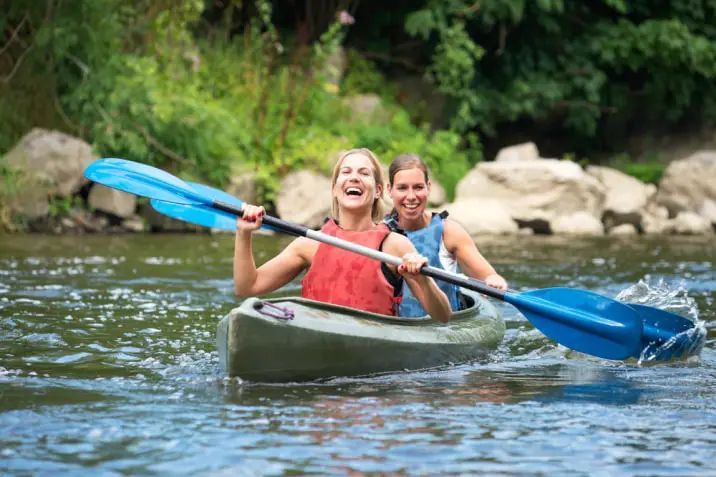
Compared to solo kayaks, tandem kayaks are longer, difficult to turn and require an increased level of synergy between the two or more paddlers onboard. Even the most experienced solo paddlers would need some practice to smoothly launch a tandem kayak and maintain the collaboration.
The following are certain things to conform to for steady tandem kayaking.
The Front Paddler Should Take the Lead
The common issue associated with tandem kayaking is the lack of any synchronization among the paddlers. This absence of unison renders the moving kayak take a directionless, zig-zag path. It creates confusion between the paddlers and could also topple the boat. To mitigate such a scenario, the front paddler should dictate the paddling pace and rhythm. The other paddler must follow the front paddler’s instructions so that there is no tracking disruption.
In case the rear paddler would like to increase speed, they should let the paddler in the front know about the same first. If the front paddler declines the idea, the back paddler should not lose heart and continue sticking to what they see in the front. The last thing you want is a paddling competition between the two paddlers.
Agreeing on the Starting Side of Paddling
Tandem paddlers can be easily confused between starting left or right. Once again, the front paddler should make the call and help coordinate things. A countdown to three would ensure a precise tandem start. Tandem paddlers are not supposed to paddle on alternate sides. That could result in the kayaking turning over since the strength of the two paddlers may not be identical.
The Weaker Kayaker Should Sit at the Front
A weaker passenger must be leading the charge because, if pushed to the back, they would have a hard time keeping up with the front-positioned, stronger kayaker’s strength and pace. If the front kayaker is paddling slowly, the kayaker at the rear should match the pace. This would create coordination, and over a period, the momentum created by the coordination will lead to increased speeds.
Rear Paddler Must Course-Correct
The front paddler isn’t just the weaker of the two but also the less experienced and skilled one. Therefore, the rear kayaker must take it upon themselves to correct the kayak’s course. This entails performing larger and stronger strokes to ensure the boat doesn’t lose track. A rudder or backstroke move might be required if the kayaker at the front goes the opposite direction. Course-correcting is not easy, but it’s vital for a smoother trip.
Avoiding Oar Contact
As mentioned previously, tandem kayaks are longer than solo kayaks so that the two kayakers have enough space to move and paddle safely. However, there is still the possibility of the paddler at the back hitting the front kayaker with their oar. This is usually the issue with beginner tandem kayakers. With practice, however, such scenarios could be phased out. If you are the rear paddler, ask the front kayaker to begin slowly so that different paddle-gripping techniques could be experimented with.
Patience is a Virtue
Tandem kayaking can get seriously frustrating, particularly during the initial stages. Therefore, the one thing that you would need the most during tandem kayaking is patience. Setting the rhythm right can be difficult if the other paddler is an absolute noob or a kid. Those little hands and their strokes would be small and slow. It’s important to keep the communication going and continue practicing. Keep going and within weeks or even days, you should be on your way.
Front Paddler Should Jump on First
Since the front paddler is the lesser experienced person of the two, this lack of experience would also show when the paddler tries to hop on to the boat. If the more experienced paddler has not taken their position yet, they would be able to help the front paddler get onto the boat.
Tandem Kayaking with Kids
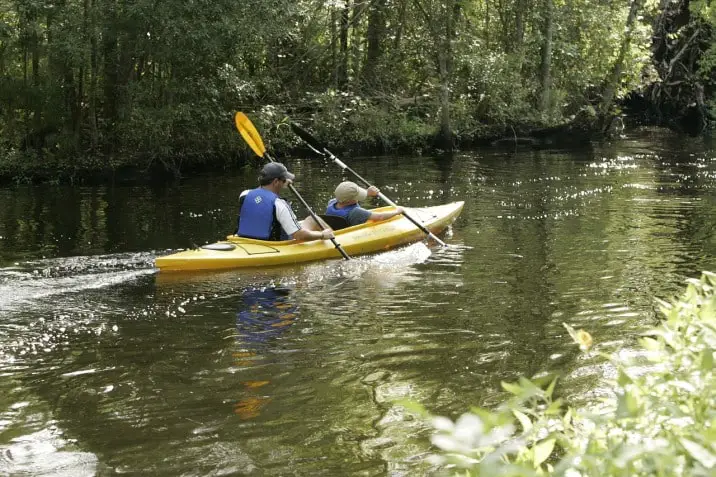
Kayaking with kids could turn out memorable. It’s a lot different than tandem kayaking with another adult. If you are considering kayaking with your kid, you should be a solid kayaker yourself. If your kayaking skill is still in its infancy stage, you should not take your kid on board. Instead, try tandem paddling with a more professional paddler, hone your skills, and then attempt paddling with your child.
Another major consideration is buying the right kayak. Even though your kid is not adult size, you should not try tandem kayaking in a solo kayak. It’s risky and not recommended at all. If possible, make sure your kid is not all by themselves in the front seat. Let your spouse or a friend lap up your kid. There should certainly not be two kids sharing a seat in a tandem kayak.
Also, always hit the calmest waters. The tandem kayaking course you take with your kid should not have categorizations or there should not be different water classes. Slow rivers are ideal, along with small protected lakes and peaceful bays. Even after having chosen the calmest and safest waters, constantly be wary of tides, currents, and kayak traffic.
Do not kayak with your kid for the entire day. The expedition should ideally be not more than an hour. If it’s your first time, keep it under 30 minutes. If your kid is fairly older (9 to 12 years), you can spend more than an hour kayaking. If a baby or toddler is onboard, try restricting the expedition to the water edges. If you’re planning a fairly long expedition, split things up into multiple short trips. Pause strategically, especially near the toilets.
Kayaking is usually a fun experience for most kids. But some may not have developed a liking for the waters. If your kid is not enjoying the experience or is not feeling comfortable during the trip, it’s recommended you cut short the excursion. Your child’s familiarity with water, ability or inability to swim, physical/mental strength and coordination, and of course, maturity or age would influence how they end up feeling about the entire experience.
Before taking your kid out for kayaking, get them acquainted with community pool water. Even better, get your kid enrolled in a swimming class for some weeks or months. If your kid is slightly older, you can teach them kayaking and paddling basics. Tandem kayaks are great for kids aged under four, but children in the four to seven age category would do better on a two-person kayak. Teenagers, on the other hand, can have their own kayaks.
Basic Kayaking Safety

First, be aware of the weather conditions, water temperature, and upcoming forecast. Check the weather radar before you leave. Ideal weather for kayaking, especially for beginners, is warm, dry weather with very little wind and calm water.
Wear appropriate clothing for the weather. If kayaking in cold water, make sure you wear an exposure suit – either a wet suit or a dry suit to help protect you from the water temperatures. If kayaking in warm weather, a lightweight long sleeve shirt and wide brim hat can protect your skin from the sun. It’s also a good idea to have sunscreen and you may even want to bring a safety whistle along with you.
Most importantly, wear a life jacket or personal flotation device (PFD). You should always wear a PFD while you are on the water so that in the event you do capsize, your head stays above water. PFDs come in various sizes depending on the weight of each kayaker. So please make sure you buy or use a PFD that fits you correctly and supports your body weight. If kayaking with a child, it’s very important they wear a PFD made specifically for children.
Tell someone else your plan. Make sure someone (other than the person you are bringing along) knows your plan for the day. Tell them where you are kayaking, which direction you are heading, how long you think you’ll be out on the water and what time you expect to be home. Once you tell them, make sure you follow the plan or notify them of any changes or delays.
Bring along plenty of water and snacks. While kayaking is a lot of fun, it is also very physical work. Make sure you bring enough water to stay hydrated (even more important on warm, sunny days) and snacks to keep you fueled and energized. We suggest bringing along a dry bag (a waterproof bag that will keep water out and also can float in the event you capsize) to place all of your personal belongings in.
Make sure you know the boating rules of the area you are in, talk to a local about the typical currents and know what times the public access, park or rental facility closes for the evening.
If you are kayaking with a young child or someone who isn’t a strong swimmer, it is a good idea to paddle along the shoreline so you can quickly get back to safety if needed.
How to Transport a Tandem Kayak
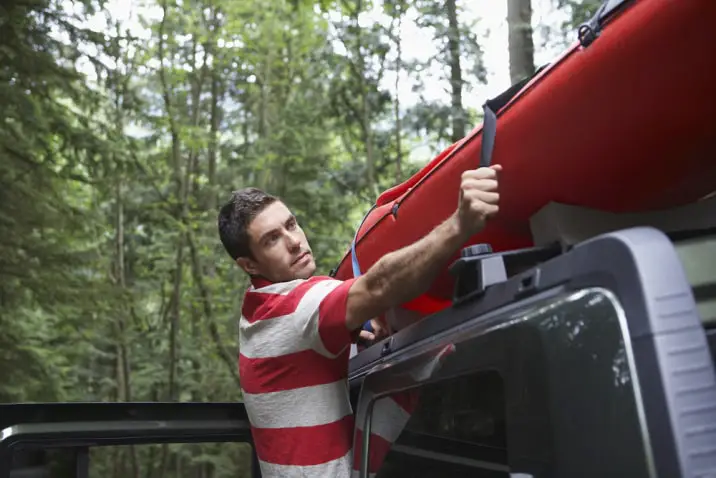
The easiest way to transport a tandem kayak is in the back of a pickup truck. The space in the back of a pickup truck will make loading and unloading much easier. Simply load it into the back of a pickup truck and then secure it by tying it down a few times.
You can also transport your kayak with a high-quality roof rack. If you choose the roof rack, be sure you know the weight limit of your vehicle’s roof and then make sure you never overload it. Get help loading the kayak onto the rack and then secure it by tying it tightly with the straps.
Remember that loose knots can completely come undone during travel and you definitely don’t want the kayak flying off the back of your vehicle. Before you leave, double-check that each strap is tied tightly and if you’re traveling a long distance, check them again each time you stop.
Get help unloading the kayak. Untie the straps, and then use the handles to lower the kayak down from the vehicle and into the body of water you will be kayaking in.
Buying A Tandem Kayak
There are multiple things to look into when shopping for a tandem kayak. Before discussing those aspects in great detail, let’s check off the basics first.
Key Specifications
Weight
Tandem kayaks usually weigh anywhere in the 45 to 100 pounds range. Some could be lighter, and a few others may be heavier. The tandem kayak you select must be able to bear and carry you and your partner, along with the fishing equipment and other things onboard. The weight of a tandem kayak also helps ascertain the boat’s stability in water and portability on land.
Boat Length and Width
Tandem kayaks are usually 20 to 30 feet long. The tandem you choose should be long and roomy enough to accommodate the feet of two paddlers. The physical dimensions should also be adequately spacious to occupy your luggage.
Comfort
Though a tandem kayak may have room for your feet, the boat in itself may not be comfortable enough to remain seated in for an extended time period. Some offer great levels of comfort, and then there are some that could be lacking a bit. A comfortable tandem kayak is one that has enough legroom and well-cushioned, sturdy seats.
Storage for Accessories
If you plan to carry multiple things while kayaking, storage space on the kayak should be a priority. Kayaks usually come with different types of storage setups. Shock cord and deck lashing are among the simpler and most common kinds. Sit-on-top tandem kayaks come with space for shock cord lashing too. In the deck lashing variant, all the items you stored would be more accessible to water. Hatches, on the other hand, are storage compartments that offer a significantly more watertight storage setup.
Seat Position
Just like single or solo kayaks, tandem kayaks come in both sit-on-top and sit-inside versions.
Sit on top tandem kayaks are generally better for beginner and recreational kayaking. They are great on lakes or other slow-moving bodies of water. Sit-on kayaks are much more fishing-friendly.
Sit inside kayaks are better for touring, which generally refers to faster and farther kayak trips taken by more experienced kayakers. They provide better control, thanks to the low point of gravity.
They also do better in quicker moving water also have the added benefit of protecting a bit more of your skin from the sun.
Warranty
Kayaks are usually protected against manufacturing defects only with their limited warranties. Try to get a kayak with the most comprehensive warranty coverage so that your mental peace remains intact during usage.
What are Tandem Kayaks Made From?
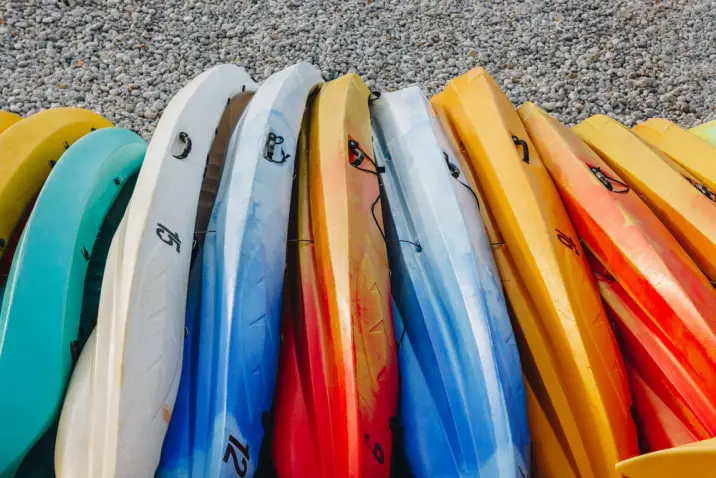
Kayaks are usually made from composite, polyethylene, wood, PVC, or thermoform ABS.
Polyethylene is basically plastic pellets melted within a mold. It’s a more durable material, needs little care, and is most importantly cost-efficient. The material is, therefore, the most popular material used to make kayaks.
However, plastics can get damaged by the sun’s UV rays. Therefore, to ensure your polyethylene-made kayak remains in solid shape always, it must be protected with a UV-blocking spray.
Composite kayaks are made of carbon fiber and fiberglass. These kayaks are, therefore, more rigid, quick, and a lot more responsive to paddling. Also, they are lighter than plastic kayaks. They are fairly durable as well but be careful not to directly bump composite kayaks into a rock or anything tough.
A negative of composite kayaks is that they are slightly on the expensive side.
Wood kayaks are another durable and lightweight option. Thanks to the material used, a wood kayak also looks a lot more elegant and environment-friendly. Unlike other kayaks, you can make your own wood kayak, provided you know more than a thing or two about kayak construction and are generally into building things from scratch.
Thermoform ABS kayaks are made of impact-resisting ABS plastic. The finish is glossy acrylic. These kayaks look similar to composites. They are light, quick, and tough. As these kayaks are cheaper to manufacture, they also sell for a fairly inexpensive price. A thermoform kayak’s price would usually be marginally greater than one constructed of polyethylene.
PVC, like polyethylene, is a very commonly used kayak material. It’s durable, easy to patch, fairly cheap, and could be welded for greater durability.
Additional Things To Consider When Buying A Tandem Kayak
There is no such thing as a tandem kayak for beginners and you should be wary of the same when you’re out to purchase one. Besides, there are a handful of other things to look into when you are tandem kayak shopping.
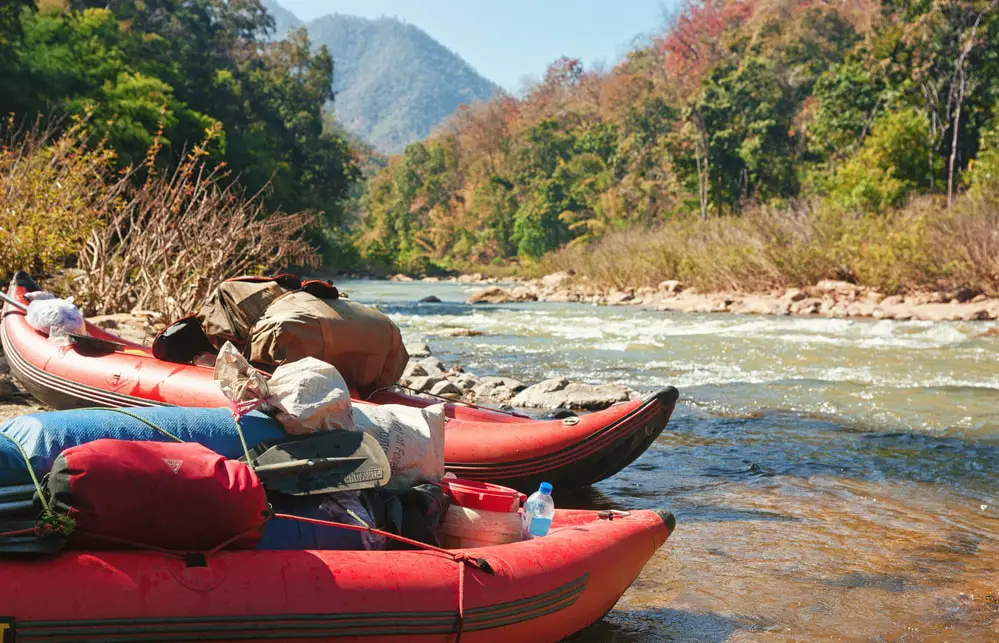
Inflatable or Rigid?
While kayaks are traditionally synonymous with hard-shelled boats, inflatable kayaks are now a viable option. These inflatables could be inexpensive inflatables to durable, high-quality vessels that rival rigid kayaks.
Inflatable kayaks, as the name indicates, should be inflated and deflated after every use. They are lightweight and much easier to store when not used, thanks to their compact footprint. The inflatables can be easily stored in your house inside a closet. They usually fold down to a duffel bag’s size and fit within a car’s trunk easily.
You would not need a roof rack, as a result. Some of these, in fact, are so compact that they even fit inside your luggage or backpack. This makes it easier to carry these kayaks overseas or in the backcountry. If you don’t have much space to spare in your house or you’re an apartment dweller, you would find the inflatable kayak more your type.
With all this being said, hard-shelled kayaks are invariably faster and more durable.
Weight Capacity
Tandem kayaks certainly come with a greater weight capacity than solo kayaks. Greater weight capacity also means increased durability. In other words, the boat would be much better equipped to withstand a well-built male, his wife, and their kid.
Generally, tandem kayaks are built keeping in mind the usual boisterousness and uncontrollable exuberance of kids aboard the kayak. So, if you have kids in the family, you should not worry much about your easily excitable kids disrupting the plane of the boat.
Paddle Compatibility
A paddle with wide blades would warrant a stronger arm movement and grip. If you and your partners are new to tandem kayaking, it’s recommended you start with a longer paddle since you would find it easy to alternate while paddling.
Shorter paddles usually require increased precision levels, which you can achieve only with continuous practice. Once you and your partner get accustomed to paddling, you may graduate to a wider paddle.
Also, if you’re planning to kayak with your kid, there are kayaks specifically built for the purpose. Look out for them.
Price
When considering price, it’s important you do not pay too little money and compromise on quality in the process. At the same time, an expensive kayak doesn’t necessarily mean the most well-built or superior kayak on the market. In other words, it’s important to strike the right balance between price and quality.
If you are new to tandem kayaking, it’s recommended you start with a kayak in the low to medium price range. In case you end up not liking the idea of tandem kayaking, a low-priced kayak would at least ensure that you did not spend too much money to start with.
Maintenance
Inflatable kayaks, as mentioned before, need inflating and deflating every time you take them out for a spin. This increases the likelihood of the kayak getting punctured or wearing down quicker than normal. This is particularly the case if the inflatable kayak is made of low-quality materials. Certain inflatable models could also be puncture-resistant, thanks to the redundant air chambers or materials used. Rigid boats do not need much maintenance. However, wooden kayaks would require more care compared to other types.
Performance
Since inflatable kayaks weigh significantly less compared to rigid kayaks, they could be a tad difficult to manage. On the positive side, however, inflatable kayaks do not capsize easily.
Rigid kayaks are quicker and more maneuverable, particularly during high wind scenarios that would blow inflatable kayaks around. In other words, rigid kayaks handle inclement weather situations better than their inflating counterparts. They are a lot more seaworthy.
The 7 Best Tandem Kayaks For Your Money
Based on features, functionality, and value for money, the following are some of the best tandem kayaks on the market.
Tandem Kayak | Type | Seating | Construction | Weight Capacity | Kayak Weight |
Ocean Kayak Malibu Two | Rigid | sit-on-top | Triple-layer polyethylene | 425 lbs. | 57 lbs. |
Advanced Elements AdvancedFrame Convertible | Inflatable | sit in | Rip-Stop fabric | 550 lbs. | 56 lbs. |
Intex Explorer K2 | Inflatable | sit in | 30 guage vinyl | 400 lbs. | 31 lbs. |
Sea Eagle SE370K | Inflatable | sit in | 38 mil PolyKrylar | 650 lbs. | 32 lbs. |
Driftsun Rover 220 | Inflatable | sit in | 1000D Reinforced Layered PVC side tubes, Heavy-duty PVC Tarpaulin bottom | 600 lbs. | 28 lbs. |
BKC UH-TK219 | Rigid | sit-on-top | High-density polyethylene | 440 lbs. | 68 lbs. |
Wilderness Systems Pamlico 145T | Rigid | sit-in | Polyethylene | 550 lbs. | 73 lbs. |
Ocean Kayak Malibu Two
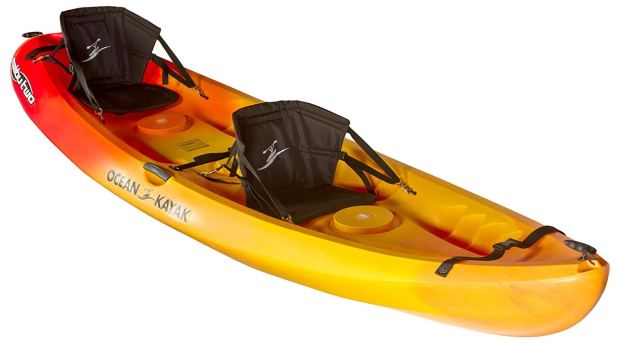
The Malibu Two by Ocean Kayak is a fairly compact, no-frills tandem kayak. Its compactness renders it easier to handle and lighter to carry around, making it a lot more convenient tandem kayak for multiple quick trips. It's a convertible, which means you can paddle it tandem or solo. Also, there's space for a small kid between the two main seats. This additional seating space and the 34-inch wide hull makes the kayak ideal for compact families.
Pros
- Can hold up to three people
- Extremely spacious
- Comfortable seats
- Big adjustable rear seats
- Overlapping footwells for increased comfort
Cons
- Paddles not bundled in
Advanced Elements AdvancedFrame Convertible Inflatable Kayak
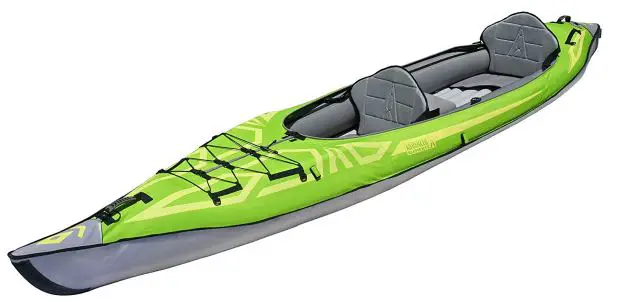
Storage and transportation are invariably the problems most kayakers run into with tandem kayaks. If a large kayak gives you logistics nightmares, the AdvancedFrame by Advanced Elements would be right in your alley. As the name indicates, you can use this kayak for both solo and tandem paddling. Weighing 52 pounds, this dainty, foldable kayak would easily go inside the trunk of a small car and still leave space for other gear. Not to mention, you can easily tuck it away when you are not actively using it.
Pros
- Customized deck configuration
- Flexible and easily convertible
- Made from durable, long-lasting materials
- Repair kit available
Cons
- Slightly on the heavier side
- No bundled-in paddles
Intex Explorer K2
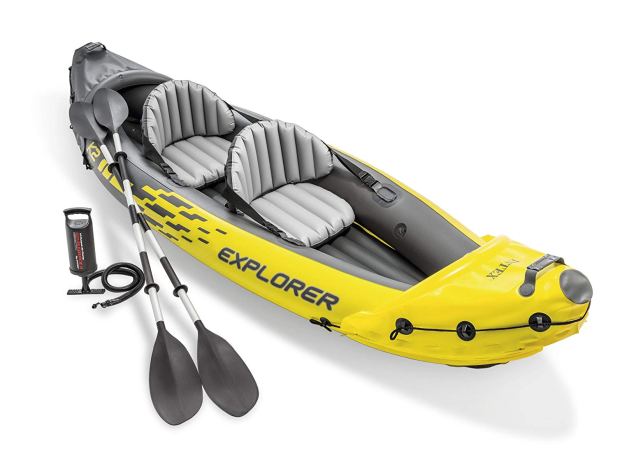
The Intex Explorer K2 offers the maximum value for the buck for a kayak. With a price of under $100, the K2 would fit in your budget (if it's constrained) without skimping on features. This two-person, 42-pound kayak is an inflatable and has a holding capacity of 300 pounds. Its highlight feature is the wide beam that provides maximum tracking ability and stability. The high-back seats offer good lumbar support. Despite the lower price tag, the kayak is built well. The frame, for instance, is a multi-layered, patented material designed to withstand the rigors of kayaking over a period.
Pros
- Affordable
- Superior tracking and stability
- Durable
- Comes with paddles
Cons
- Not for rough waters
Sea Eagle SE370K Inflatable Kayak
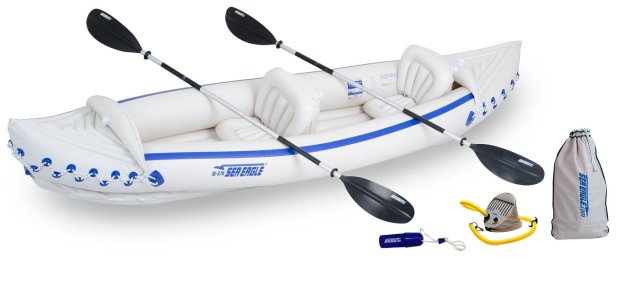
The SE370K by Sea Eagle is a lightweight, NMMA-certified inflatable kayak that lets you sit back and relax while cruising or race down turbulent waters. It's ideal for all kinds of kayakers. Despite being meant to carry two people simultaneously, the 32-pound weight means the kayak is ideal for solo kayaking too. Most notably, it can hold weight up to 650 pounds.
Pros
- Sun and saltwater-resistant material
- Self-bailing draining valve
- Easy to haul
- Inflates and deflates fairly quickly
Cons
- Not suitable during extremely cold conditions
- Single strap design can pose issues when transporting
Driftsun Rover 220
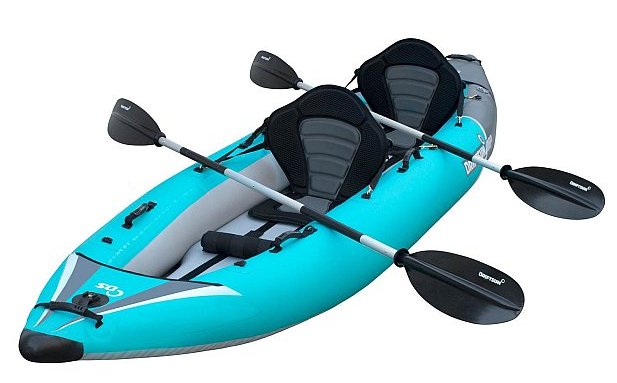
The Driftsun Rover 220 is an inflatable tandem kayak that would work in diverse kayaking environments. Weighing just 28 pounds, the Rover 220 is easy to carry around and can be inflated in approximately nine minutes. The reinforced layer materials lend it a solid build. The holding capacity is 600 pounds and offers more than enough room for two adults and a kid. You can also carry your camping and fishing gear at the same time. The reliable build and well thought out design make this Driftsun a complete tandem boat for families.
Pros
- Rugged and durable
- Lightweight and compact
- Front camera mount
- Solid weight capacity and generous space
- Comfortable seating
Cons
- Marginally expensive
BKC UH-TK219
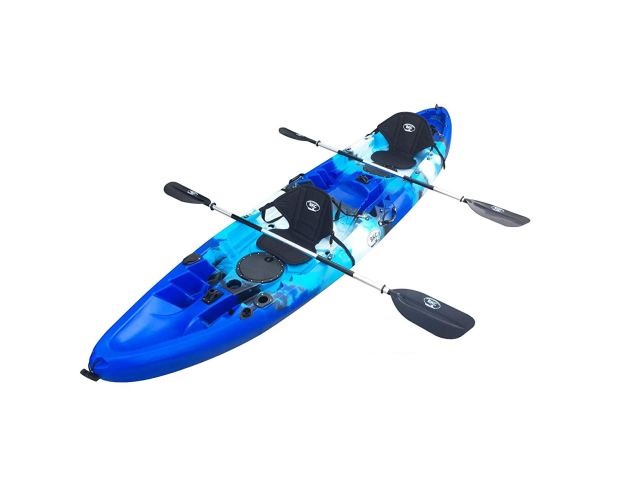
The UH-TK219 from BKC (Brooklyn Kayak Company) comes with some modern features. This 70-pound boat can also be used as a three-person kayak that would comfortably hold a weight of up to 440 pounds. The kayak is spacious and would easily accommodate all your fishing equipment, thanks to the adjustable hookers and rod holders. The TK219 is arguably the best tandem kayak for fishing on this list.
Pros
- Accommodates up to three people
- Smooth sailing experience
- Comfortable deluxe seats
- Ample room for fishing equipment
Cons
- Slightly on the pricier side
- No seat for the third person
Wilderness Systems Pamlico 145T Tandem Kayak
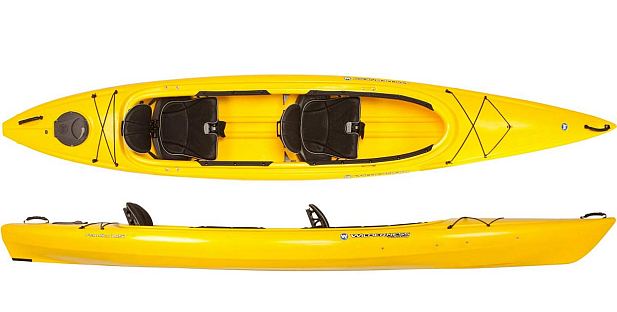
For the more serious kayaking duo, this Rudder Ready tandem kayak was designed for comfort for extended kayaking sessions. It features thigh and knee padding as well as the Keepers XL Foot Brace System to ease the discomforts of paddling. As a very customizable kayak, the Pamlico 145T offers several adjustability options with upgraded seating. It comes with Comfort Carry handles and includes an Orbix stern hatch to store your gear. The open cockpit design will support a weight of up to 550 pounds.
Pros
- Designed for comfort
- Signature rounded hull
- Removable seat for solo paddling
- Bungee deck rigging
Cons
- Higher price range
Conclusion
As you can see, kayaking is both a fun adventure and really great exercise. Being able to take a loved one along for trip is a really special benefit of tandem kayaking.
Hopefully you have learned some new tips and you’re feeling a lot more confident about taking a tandem kayak out onto the water, perhaps for the very first time! So find a beautiful, calm body of water, invite someone you love along and enjoy an amazing kayak trip for two.
At the end of the day, it’s all about learning your kayaking requirements and knowing what to look for in a tandem kayak. If you get these two things right, tandem kayaking would turn out a pretty solid experience for you.

